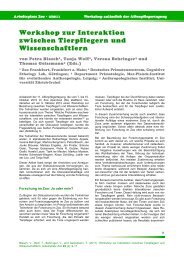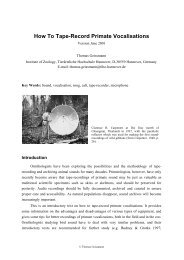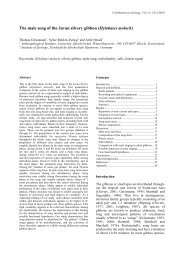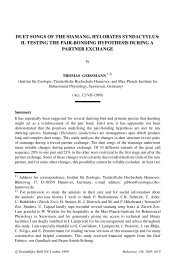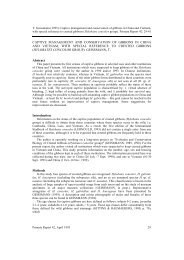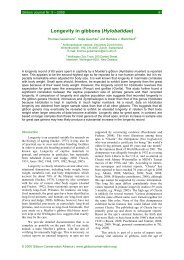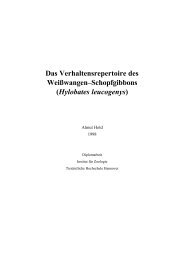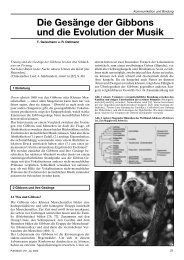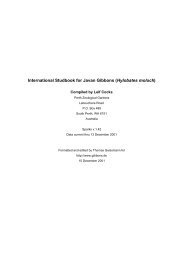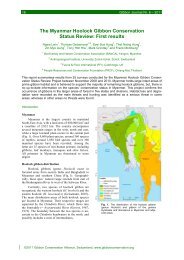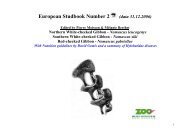Geissmann, T., 2000: Duet songs of the siamang, Hylobates ...
Geissmann, T., 2000: Duet songs of the siamang, Hylobates ...
Geissmann, T., 2000: Duet songs of the siamang, Hylobates ...
You also want an ePaper? Increase the reach of your titles
YUMPU automatically turns print PDFs into web optimized ePapers that Google loves.
T. <strong>Geissmann</strong>: Siamang <strong>Duet</strong> Songs<br />
effect is, apparently, neutralised when <strong>the</strong> throat sac is deflated during <strong>the</strong> second<br />
phase <strong>of</strong> <strong>the</strong> bitonal scream.<br />
During this study, however, high quality tape-recordings <strong>of</strong> <strong>songs</strong> <strong>of</strong> various<br />
<strong>siamang</strong> males (e.g. Na and Bh) made it possible to see a very weak additional frequency<br />
band below what has previously been believed to be <strong>the</strong> fundamental frequency<br />
<strong>of</strong> <strong>the</strong> first phase <strong>of</strong> <strong>the</strong> bitonal scream (<strong>the</strong> lowest <strong>of</strong> <strong>the</strong> 3 bands visible in<br />
Fig. 1i). This weak band appears to be <strong>the</strong> real fundamental frequency <strong>of</strong> this phase.<br />
Its intensity is considerably lower than that <strong>of</strong> <strong>the</strong> first harmonic, suggesting that <strong>the</strong><br />
fundamental frequency is at least partially filtered away. The high frequency attributed<br />
by LAMPRECHT (1970, p. 188) and WEST (1982, p. 16) to <strong>the</strong> first phase<br />
<strong>of</strong> <strong>the</strong> bitonal scream (1.13-1.21 kHz and 1.08-1.23 kHz, respectively), refers,<br />
<strong>the</strong>refore, to <strong>the</strong> first harmonics (as correctly suggested by LAMPRECHT, 1970),<br />
and not to <strong>the</strong> fundamental frequency. According to <strong>the</strong> measurements carried out in<br />
<strong>the</strong> present study, <strong>the</strong> real fundamental frequency <strong>of</strong> <strong>the</strong> first phase <strong>of</strong> <strong>the</strong> bitonal<br />
scream is situated between 0.36 and 0.82 kHz and is clearly lower than that <strong>of</strong> <strong>the</strong><br />
second phase (0.42-1.00 kHz).<br />
The captive male <strong>siamang</strong> observed by BRICKNELL (1992) produced bitonal<br />
screams, in which no first phase was visible on <strong>the</strong> sonagrams at all, and with <strong>the</strong><br />
second phase "starting at a frequency <strong>of</strong> 1.8 kHz and ending at 1.3 kHz". This range<br />
is situated above that <strong>of</strong> all males heard during <strong>the</strong> present study (0.42-1.00 kHz).<br />
The bitonal screams uttered by that male appear to be atypical.<br />
The bitonal scream is almost always combined with locomotion. Usually, <strong>the</strong> calling<br />
animal moves only a short distance, by swinging itself to ano<strong>the</strong>r branch or sitting<br />
place; sometimes <strong>the</strong> animal merely changes its position.<br />
Similar to <strong>the</strong> ululating scream, <strong>the</strong> bitonal scream is associated with o<strong>the</strong>r vocalisations,<br />
thus forming a particular phrase. The phrase begins with a short boom, or<br />
– in some individuals <strong>of</strong> this study – a pair <strong>of</strong> booms consisting <strong>of</strong> an ascending<br />
boom followed by a short boom. After <strong>the</strong> short boom, <strong>the</strong> animal utters its bitonal<br />
scream, which is in some animals followed by a number <strong>of</strong> short fast barks. The<br />
bitonal scream phrase is, <strong>the</strong>refore, similar to <strong>the</strong> ululating scream phrase in its<br />
structure. Here, too, some individual characteristics are evident. They include <strong>the</strong><br />
frequency modulation, <strong>the</strong> intensity <strong>of</strong> <strong>the</strong> scream, and <strong>the</strong> number, structure and<br />
interval duration <strong>of</strong> its accompanying phrase elements. In this study, <strong>the</strong> two males<br />
Bh and Na produced a short series <strong>of</strong> 1-4 short fast barks immediately after <strong>the</strong><br />
scream, whereas no barks were uttered after <strong>the</strong> bitonal screams <strong>of</strong> ano<strong>the</strong>r male<br />
(Bb). These particular barks also appeared to be missing in <strong>the</strong> males observed by<br />
HAIMOFF (1981), MAPLES et al. (1989) and WEST (1980), as well as in two <strong>of</strong><br />
four males in LAMPRECHT's (1970, p. 197) study. One <strong>of</strong> <strong>the</strong> males <strong>of</strong> this study<br />
(Bb) always produced <strong>the</strong> first phase <strong>of</strong> his bitonal scream so s<strong>of</strong>tly, that it was sometimes<br />
difficult to hear when <strong>the</strong> male was duetting with a female. The second phase<br />
<strong>of</strong> this male's bitonal scream, however, was <strong>of</strong> <strong>the</strong> normal intensity. In exceptional<br />
cases, all males can omit <strong>the</strong> second phase <strong>of</strong> <strong>the</strong> bitonal scream. One <strong>of</strong> <strong>the</strong> males<br />
observed by WEST (1980, p. 12) in Sumatra always produced only <strong>the</strong> first phase.<br />
It is not clear, whe<strong>the</strong>r <strong>the</strong> two phases <strong>of</strong> <strong>the</strong> great call are both produced during<br />
exhalation, as suggested by Haim<strong>of</strong>f (1981, 1983b), or whe<strong>the</strong>r one phase is an inhalation<br />
note.<br />
The bitonal scream is only known from male <strong>siamang</strong>s. RÜHMEKORF (1963)<br />
described bitonal screams <strong>of</strong> a female <strong>siamang</strong>, but, at that time, <strong>the</strong> sex <strong>of</strong> this<br />
44 Primate Report 56, April <strong>2000</strong>



